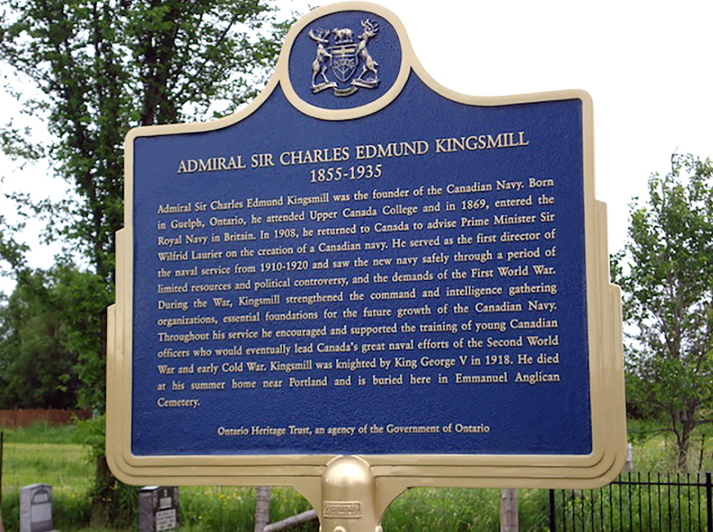Rideau Lakes is filled with intrigue and local curiosities around every bend! Seek out these historic monuments to visit and discover more about the heritage and cultural fabric of this beautiful region.
The Red Brick School
This beautiful building is easily identified by its construction of red brick with yellow brick corner detailing. Located in Elgin, it’s known as a premier example of a late 19th-century campaign to improve public education through the building of a more stimulating environment for learning. This “fine school house” functioned as such from 1887 to 1964. The Red Brick School is a particularly lovely example of a rare, rural, architect-designed, educational structure. Look here for special events and summertime tours hosted by the active and engaging Elgin and Area Heritage Society.
 Red Brick School photo submitted by Diane Haskins
Red Brick School photo submitted by Diane Haskins
Rideau Canal Lockstations
Rideau Lakes offers a rich cultural landscape and great diversity of natural treasures highlighted by the Rideau Canal UNESCO World Heritage Site. With six lock stations within the Township of Rideau Lakes, including Poonamalie, Newboro Lock, Narrows Lock, Jones Falls, Davis Lock and Chaffey’s Lock, the establishment of the canal completed almost 200 years ago profoundly influenced the settlement, commerce and tourism of the area. Visit a lock station to discover tangible history in action – with the engineering marvel of the 19th century still operating under the direction of Parks Canada!

Mission on the Mountain
As Irish immigrants began to call Rideau Lakes home, travelling priests provided religious services to the community. The first Catholic church in the township was built on Parish Road in 1840 on land donated by an immigrant hailing from Northern Ireland. The log structure became known as the Mission on the Mountain. Now, surrounded by serene evergreen forest, a large stone cross stands at the site to commemorate the church, associated school and its Irish heritage.
 Mission on the Mountain photo submitted by Rosanne Lake
Mission on the Mountain photo submitted by Rosanne Lake
Old Stone Mill National Historic Site
Built in 1810, this prized mill site is now a museum – and operating grist mill! Completely renovated working millstones were installed for its 200th anniversary in 2010. The mill is open seasonally from Victoria Day weekend to Labour Day and during special events, where it continues to grind locally grown heritage Red Fife wheat.
 Old Stone Mill photo submitted by Marie White
Old Stone Mill photo submitted by Marie White
Admiral Sir Charles Edmund Kingsmill gravesite
The Founder of the Canadian Navy is buried in Emmanuel Anglican Cemetery near Portland. Yes, you read that correctly! Surrounded by hedges within the cemetery and complete with a commemorative plaque, it is noted that Admiral Sir Charles Edmund Kingsmill entered the Royal Navy in Britain, returning to Canada to advise Prime Minister Sir Wilfrid Laurier on the creation of a Canadian Navy in 1908. During the First World War, Kingsmill strengthened the command and intelligence gathering organizations, essential foundations for the future growth of the Canadian Navy. Kingsmill was knighted by King George V in 1918. He died at his summer home near Portland in 1935.
 Admiral Sir Charles Edmund Kingsmill gravesite plaque photo Canada.ca
Admiral Sir Charles Edmund Kingsmill gravesite plaque photo Canada.ca
Royal Sappers and Miners Cemetery
The Royal Sappers and Miners were a group of skilled craftsmen from Ireland, England and Scotland who supported the development of the Rideau Canal. Look for a plaque and cemetery in their memory at Newboro, the Royal Sappers and Miners consisted of 160 skilled craftsmen and labourers under the Royal Engineers. The 7th Company transferred to help in the completion of the canal at the Isthmus, the only section beyond Bytown built under direct military supervision. Fun fact: the height of land at the Isthmus - the area around what later became Newboro – had to be excavated to link two watersheds. According to the Rideau Lakes website, “This cut, through Precambrian bedrock, presented one of the greatest challenges of the Rideau Canal construction. Its completion came at the cost of the lives of labourers, as well as soldiers from the 7th Company of Royal Sappers and Miners, who died as a result of accidents and malaria. Nevertheless, these soldiers and labourers, along with their families, formed another influx of residents, some of whom settled in North Crosby.” Discover more about the Royal Sappers and Miners here.
 Replica Blockhouse at the Royal Sappers and Miners Cemetery by Marie White
Replica Blockhouse at the Royal Sappers and Miners Cemetery by Marie White
Chaffey’s Lockmaster’s House Museum
This heritage building was constructed in 1844 as a low-cost substitute for a blockhouse to defend the canal against American-based raiders. The Chaffey's Lockmaster's house was originally a one-storey limestone building. A tin roof protected it in case of fire and two stone porches and gun-slits provided extra defence in case of attack. The house was occupied continuously from 1844 until 1967, by only five lockmaster's families. In 1894 it was renovated and a frame second-storey and kitchen addition were added; the house quickly became a social centre of the hamlet known as a meeting place for boaters and locals alike. The history of Chaffey's Lock and the surrounding area is now depicted at this important community museum. In summer, video and interpretation of the site are offered for free with donations accepted!
 Chaffey's Lockmaster House Museum
Chaffey's Lockmaster House Museum
Celtic Cross in Chaffeys Lock
Have you seen the elaborate Celtic cross in Chaffey’s Lock? According to Rideau historian, Ken Watson, about half to two-thirds of the labour force that built the Rideau Canal were immigrant Irish. As such, a large Celtic cross stands near the community hall in Chaffey’s Lock, in memory and recognition of the canal workers who lost their lives building the Rideau Canal. In fact, a plaque at the cemetery nearby to honour Irish workers in Chaffey’s reads, “This half-acre cemetery became the final resting place for many Irish immigrants who died at Chaffey’s Mills during construction of the Rideau Canal. Chaffey’s Mills was one of several locks and canal construction sites where malaria, a disease not understood then, devastated the labour force. During the late summers of each year from 1828 to 1832 up to 95 per cent of the workers were stricken. Most of these Irish immigrants had no family or ties here… no record exists today of their names to enable us to honour them as individuals who helped build this country… this plaque is dedicated to the memory and contribution of those brave Irish immigrants.”
Historical Plaques
Hungry for more history? Tour around Rideau Lakes discovering all the historical plaques to learn more about heritage here! With plaques telling about James Philips in Philipsville; Lieutenant-Colonel John By in Jones Falls; Dr. Lorne Pierce in Delta; the Founding of Newboro and more, these Ontario Heritage Trust plaques are a great public way to get to know the Rideau Lakes region. Some are also featured in more detail on the Rideau Lakes Heritage Driving Tours and Heritage Walking Tours. Community storyboards in villages such as Elgin, Portland, Delta and Newboro tell stories about local champions for change and community, as well as shining a light on the cultural heritage in each locale.

Historic monuments are a great way to discover the rich heritage and intriguing cultural landscape in Rideau Lakes!



















